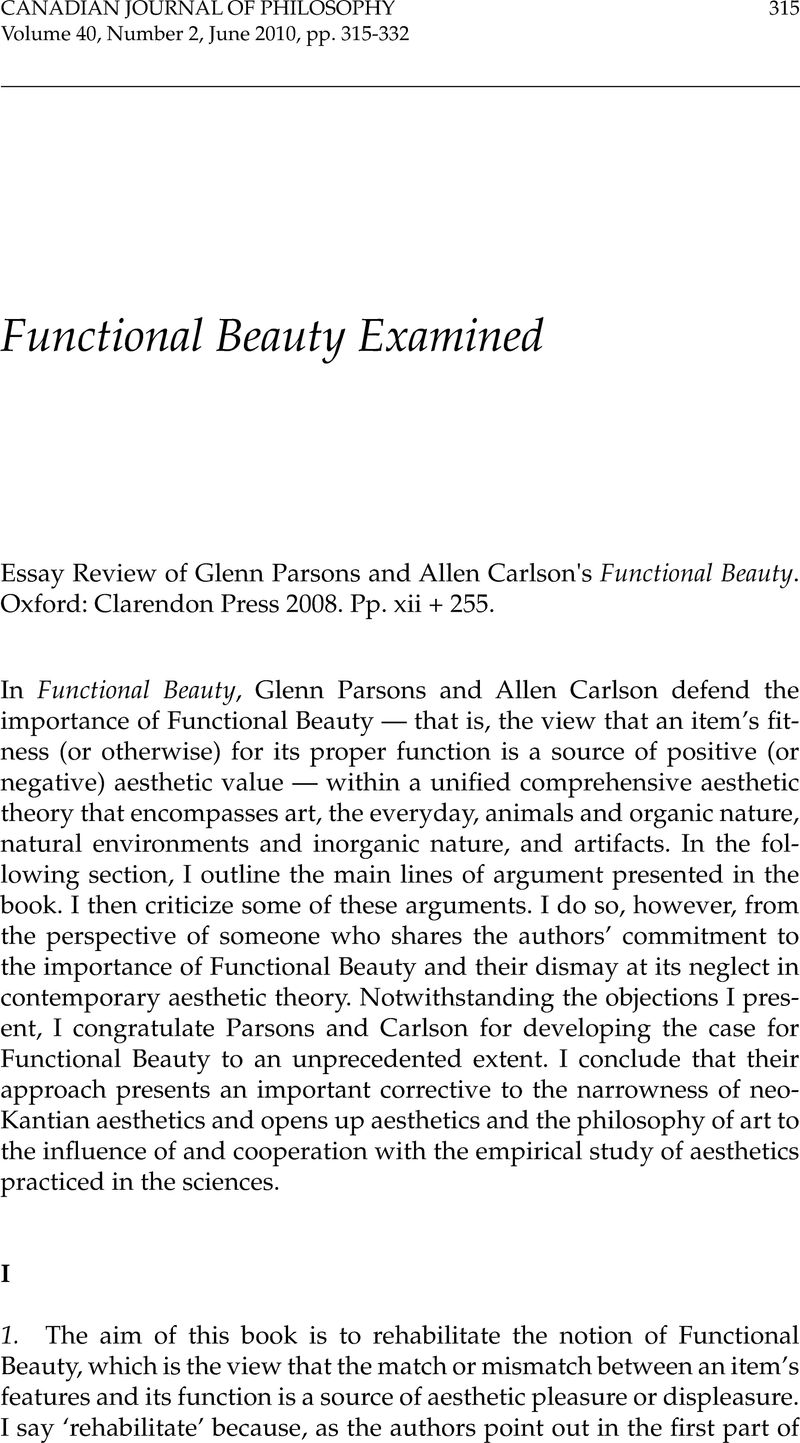Published online by Cambridge University Press: 01 January 2020

1 Tatarkiewicz, Wladyslaw ‘The Great Theory of Beauty and its Decline,’ Journal of Aesthetics and Art Criticism 31 (1972) 165–80Google Scholar
2 Guyer, Paul ‘Beauty and Utility in Eighteenth-Century Aesthetics,’ Eighteenth-Century Studies 35 (2002) 439–53Google Scholar
3 In Davies, Stephen ‘Aesthetic Judgment, Artworks and Functional Beauty,’ Philosophical Quarterly 56 (2006) 224–41,CrossRefGoogle Scholar I have drawn a similar distinction in trying to locate the relation between aesthetic qualities and function that best characterizes what I also call functional beauty (see 237-8): in the case of functional beauty there is not merely a conjunction of, say, elegance and practicality but rather a manner of realizing the function that is at the same time aesthetically enhancing, so the item is elegantly practical. The item is beautiful both through the manner in which it realizes its nature or function and as a result of its realizing its nature or function in that way.
4 Based on Cummins, Robert ‘Functional Analysis,’ Journal of Philosophy 72 (1975) 741–65.CrossRefGoogle Scholar
5 Based on Godfrey-Smith, Peter ‘A Modern History Theory of Functions,’ Noûs 28 (1994) 344–62CrossRefGoogle Scholar and Preston, Beth ‘Why is a Wing like a Spoon? A Pluralist Theory of Function,’ Journal of Philosophy 115 (1998) 215–54.CrossRefGoogle Scholar
6 Walton, Kendall L. ‘Categories of Art,’ Philosophical Review 79 (1970) 334–67CrossRefGoogle Scholar
7 The emphasis on appearance in these examples is perhaps misleading. The point, I assume, is not only that the car looks fast and the castle impregnable but also that the car's speed and the castle's invulnerability depend on the qualities that give them the appearances in question.
8 See Brock, Gillian and Atkinson, Quentin D. ‘What Can Examining the Psychology of Nationalism Tell Us about Our Prospects of Aiming at the Cosmopolitan Vision?’ Ethical Theory and Moral Practice 11 (2008) 165–79.CrossRefGoogle Scholar
9 Walton, ‘Categories of Art,’ 346Google Scholar
10 Walton, ‘Categories of Art,’ 352Google Scholar
11 This is the position I defend in ‘Aesthetic Judgment, Artworks and Functional Beauty.’
12 Wittgenstein, Ludwig Lectures and Conversations on Aesthetics, Psychology, and Relgious Belief, Barrett, C. ed. (Oxford: Basil Blackwell 1978),Google Scholar at 17 & 19. Wittgenstein's main point was that underlying causal mechanisms do not explain or justify aesthetic judgments. And to be fair, the dominant paradigms in psychology in the late 1930s, when Wittgenstein was speaking, were less appealing and relevant than those of today.
Relgious Belief, C., Barrett ed. (Oxford: Basil Blackwell 1978)Google Scholar, at 17 & 19. Wittgenstein's main point was that underlying causal mechanisms do not explain or justify aesthetic judgments. And to be fair, the dominant paradigms in psychology in the late 1930s, when Wittgenstein was speaking, were less appealing and relevant than those of today.